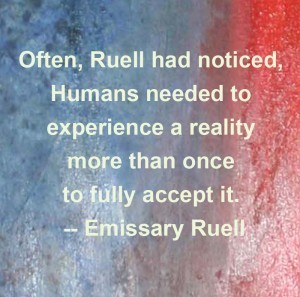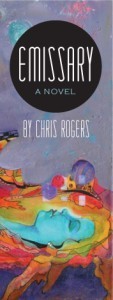Chris Rogers's Blog, page 24
October 11, 2014
Strong Characters Have Strong Emotions
Fictional characters we remember do not have wishy-washy attitudes. They care deeply. We may not agree with them, but that’s okay. In fact, when a character can make a reader fearful, sad, angry, frustrated, or laugh-out-loud happy, that’s a great character.
Villains are easier in this respect, because we don’t have to like them. Usually, we also don’t spend as much time with them on the page. In fact, there’s a saying, “Don’t trot your monster out too often.”
Students often ask, “How can I make my hero as interesting as my villain?”
The answer: Make them care.
Maybe they’ll face down the worst villain but they’re petrified of fire – or lightning storms – or snakes. And, of course, there’s a seminal event in the past that caused this fear.
Maybe they have such a love of animals that they become violent against anyone who mistreats one.
Or maybe they believe in ghosts, and have a deep caring for lost souls that can’t seem to find their way.
Or maybe children, or homeless people, or they only feel complete at peace when fly fishing or climbing a mountain.
And how do you reveal these emotions to the reader?
Create a situation in which the character can’t help but respond, then show the internal and external conflict that emerges.
Create a dialogue with someone who holds completely opposite feelings – and don’t let them swallow it. Give both characters a strong position and reveal both sides.
Create a situation in which the character is prevented from doing what s/he most wants to do, and illustrate the internal/external conflict that emerges.
Give your hero a sidekick, and remember: the best sidekick doesn’t always agree with the hero’s ideas. They might kill for each other, but like siblings, they disagree.
It’s with people we care about that our emotions most erupt.
Being something of a loner myself, I tend to fall into this trap frequently, and it happened when I wrote the first draft of Emissary. After losing his family, Officer Kirk Longshadow had closed himself off – which is realistic and necessary for my plot to play out, but he had no one to “play against.” To keep from “telling” how he felt, to instead “show” important aspects of his personality, I had put various characters in his path, if only for a few scenes each.
The most memorable books have strong characters who act out their emotional storms – negative or positive – even when those storms make a reader uncomfortable. Those are the characters that become real enough to climb right out of the book and sit with us. Pre-Order Emissary now at charthousepress.com/books/emissary
Making a Point
As writers, we have to step into our characters’ skins and know them. In writing Emissary, I became, at various stages, a Houston cop, the US president, the president’s press secretary, a vicious dictator, a mercenary, and an emissary from a dying planet.
This can be great fun.
It can also be eye-opening. Regardless of what we choose to show the reader, we have to know not only our characters’ best traits but their worst, their strengths as well as their imperfections, their thoughts and, no matter how alien to us, their feelings.
Emissary Ruell is young and inexperienced yet desperate to save the refugees from his lost world. To accomplish his mission, he is experiencing Humans up close and personal. I had to ask myself what he would notice about us.
One thing—out of many—is that we aren’t easily convinced. Sometimes we don’t notice what’s right in front of us, other times we might choose to ignore it, and occasionally we disbelieve no matter how compelling the evidence.
Our readers are Human. In crafting a story, we might need to make them pay particular attention at one point but miss another point entirely. Here’s how we do it:
To make a point stick, embellish it with sensory variation.
Example: Tommy is sick but doesn’t want his mom to know. He thinks, Gosh, my stomach feels wonky. He hears his older brother yell, “Mom, we’ve got to go. The game starts in ten minutes!” He sees his new shirt in the school’s game colors. He rushes toward the toilet but vomits on the bathroom floor, then hurriedly wipes it up with a towel. Rinsing the taste of bile from his mouth, he notices his grim expression in the mirror and forcibly changes it to a smile before facing his mom.
Here’s the lazy way: Tommy felt sick, but he wanted to go to the game.
The first example uses more words, but doesn’t it make the point sink in?
PRE-ORDER Emissary now at charthousepress.com/books/emissary
October 10, 2014
How Long is Too Long?
What’s your opinion of thick books versus thin? Some of what I call “flukes” of recent past became “instant” bestsellers, in my humble opinion, partly because they were short enough for a quick read. Among these, Bridges of Madison County by Robert James Waller runs 208 pages, a reasonable length, while The Christmas Box by Richard Paul Evans is barely 128 pages.
When writing students ask how long a book should be, my answer is always, “As long as it needs to be to tell the story.” And I believe that. Yet, in reviewing the Advanced Reader Copy of Emissary for final revisions before its publish date, December 2, I was about 50 pages in when it seemed to be getting “longish.”
How do I explain that other than to say it was starting slow. Now, this was a proof-read, checking for typos and such, which is quite different from reading a book fresh. Another thing I tell students is, “Grab the reader’s attention on the first page and hold it.” Had I done that? I certainly thought so, but then why was it feeling longish?
To bolster confidence, I checked the page count on some of my favorite Stephen King books. Like me, he believes a story should be as long as it needs to be and, also like me, he likes to introduce his characters before dropping a body out of the air. Doctor Sleep, 560 pages. The Shining, 688 pages. The Stand, a whopping 1200 pages. Then just for fun, I checked out J.R.R Tolkein’s Lord of the Rings, 1178 pages, and Leo Tolstoy’s War and Peace, 1296 pages. Next to that lineup, Emissary at 434 pages didn’t seem longish at all.
And I have to confess, as I read deeper into the book and became reacquainted with characters I had set aside for awhile to get some distance before proofing, the pages turned faster, and I was enjoying the story all over again.
Long or short, my favorite books are those I can read with pleasure again and again, even when they’re my own (she said modestly). This one’s a keeper.
Pre-Order Emissary now at charthousepress.com/books/emissary
October 7, 2014
The Top is a Lonely Place
“Cold tea, sixteen-hour work days and nasty thrumming headaches came packaged with all the glory of the presidential chair.” – U.S. President Addison Hale, from the cross-genre thriller, Emissary.
When I first heard the quote, “There’s plenty of room at the bottom,” I didn’t know it came from the famous speech by Richard Feynman that foreshadowed the science of nanotechnology. For me, the statement conjured up a completely different meaning that made perfect sense.
In our plans for the future as writers and artists, who doesn’t dream of reaching the top? After all, we only hear of those who make a big splash in their field or a revered place in history. Yet for every Michelangelo and Picasso, for every Dickens and Poe and Twain, for every Paul McCartney and Bob Dylan there are thousands of hardworking artists, writers, and muscians who create beautiful works.
One of my favorite writers is T. J. McGregor, aka Trish Janeschultz, aka Alison Drake. Author of 30 novels, including Out of Sight a winner of the 2002 Edgar Allan Poe award for Best Paperback Original, McGregor does not come instantly to mind when we speak of “bestselling” authors. Nevertheless, she is a talented craftsman, and I love her work.
Perhaps this idea was behind my thoughts when I created President Addison Hale as one of three major players in my latest novel, Emissary. Addison never expected to win the election when she agreed to run. Her goal, as with most third-party contenders, was merely to get her party’s issues in front of the American people. Targeted and nearly killed by a sniper, she made national headlines at precisely the moment when voters were trying to decide between two major-party but equally unpopular candidates. And once in office, she struggles to do the best job possible even as she learns that it’s cold at the top. As she attests in the book, “Among her political adversaries, she was a bug under a microscope.”
Emissary is available now for pre-order at: ChartHousePress.com/Chris-Rogers/
September 11, 2014
THIS is the Workshop I Wish I’d Found in My Early Years of Writing
Why? Because this Workshop reveals the elusive qulaity editors want – and the quality readers truly want, even when they don’t realize it. More important, this workshop reaches past the usual plot-plus-character jargon and shows how to capture that elusive quality in your story.
Elusive? Yes. For example, in 15 seconds, can you add a single word to each of the following words and create a recognizable phrase? THROAT, LOSER, SPOT.
Only 20 seats are allotted for this powerful, hands-on seminar: Increase Your Story’s Vitality
REGISTER NOW:writespacehouston.org/weekend-workshops.html
713/516-5679 mobile
DATE: Saturday, September 20th, 1:30-4:30
LOCATION : Writespace, north of downtown Houston
ADDRESS : 2000A Edwards #212, Houston, 77007
PRICE: $30
Did you answer the question above? If so, was your answer one of the following: biggest, deep, black? If, instead, you answered correctly with SORE, pat yourself on the back. But now – what important writer’s tool did you just discover? And how can you use it to merge character with setting?
As a successful author, ghostwriter, and teacher of fiction and narrative nonfiction writing, I was rather amazed to discover I was overlooking a key element, even though that element somehow found its way into my work. When we write well intuitively, that’s a gift – a wonderful gift – but only when we know how to create the same effect again and again, on purpose, can we depend on it.
Never before has this powerful material been included in my classes, not at Rice University School of Continuing Studies, University of Houston Extension Program, The Women’s Institute of Houston, nor at national or local seminars – because I only recently winnowed it from my own studies. You can be one of the first to experience this unfolding.
REGISTER NOW: writespacehouston.org/weekend-workshops.html
713/516-5679 mobile
Take another 15 seconds and answer this one: Which famous author of classical fiction frequently started his story with an ear worm to engage readers?
In this Workshop, you will discover how an ear worm can be addictive and how you can use this addiction to engage readers at any point in your story. And by the way, if you answered Charles Dickens, you’re right.  To learn more, REGISTER NOW.
To learn more, REGISTER NOW.
This time, take a full minute to determine how the following sentence includes 4 little known writer’s tricks to capture a reader. “My God,” said the Queen, “let go my leg.” 
Only 20 seats – and they’re going fast. With restricted attendance, you can be certain of getting the hands-on attention you want when committing your valuable time to a classroom.
September 20, 2014, 1:30-4:30 pm.
Writespace Houston
REGISTER NOW: writespacehouston.org/weekend-workshops.html
713/516-5679 mobile
Afterward, celebrate at the pre-launch of my new cross-genre thriller, Emissary .
 Reading and Pre-Launch Party with Chris Rogers
Reading and Pre-Launch Party with Chris RogersLocation is the same, Writespace, time is at 5 pm.
Come celebrate the advent of award-winning Houston author Chris Rogers’ newest novel. During this pre-launch, Chris will read from her upcoming novel and share a bit about her experiences writing it. Come ready to ask questions about writing and publishing, because after her reading, Chris will offer a Q&A, and she loves to guide new writers. Light refreshments will be served. Come prepared to have fun and win prizes! FREE DRAWING.
REGISTER NOW: writespacehouston.org/weekend-workshops.html
713/516-5679 mobile
August 28, 2014
Increase Your Story’s Vitality: What Every Editor Wants
Saturday, September 20th, 1:30-4:30
Great editors at publishing houses know their readers. They know the qualities a book must have to sell well, and when your story delivers those qualities from start to finish, an editor will fight to get it for their line.
Bitch Factor, the first book in my Dixie Flannigan suspense series, created enough stir in New York that my agent called me and said, “There’s a tiny auction going on, Chris. Several editors want your book.” Silly me, I didn’t know what a big deal that was.
Years later, I discovered the quality those editors saw, which I had created without realizing the importance: Emotional Impact. That doesn’t mean “melodrama” or “horror” or “tragedy” or “sappy first love” or “forbidden love” or “laugh out loud humor” or any one thing we might label as emotional. It means an emotional connection with the reader. A reader cannot pick up your book without wanting to finish it and cannot close it without wanting more.
At the September 20 Workshop You’ll Learn How to Deliver Emotional Impact
Character and Place, when tightly woven, can help you create the emotional ride that readers – and thus, editors – want from fiction or narrative nonfiction. Why? Because the weaving of these two key elements can reflect a character’s fears, desires, and problems more effectively than merely trying to describe feelings. It tightens the reader-character bond.
If you ask a reader, “what do you want to feel when reading a good story,” you’ll likely get a blank stare. Most readers rarely think about it. But you can bet there’s a subconscious tug going on if your story delivers the emotional goods. That reader is likely to buy your next book. A book that ties up all the plot threads but fails to deliver an emotional ride will rarely provide the satisfying completion that makes a reader hunger for your next story.
Writers often prefer not to think about reader satisfaction. They’d rather “just write” (right-brain). Or they’d rather work and rework the plot details (left-brain). But you can bet editors are thinking about reader satisfaction from the moment they open that first page.
Here are some of the topics we’ll discuss for creating a tightly woven Character-Place bond:
Tone, style, language, pacing
Opening incident and setting the stage for what’s to come
Belief in the narrator
Sensory details, mechanics, minutia
Buildup, Middle lag, Ending punch, POV wrap-up
Can So Many Bestsellers All Be Wrong?
There are many ways to write a good story. I won’t try to tell you “this is it, this is the only way to get noticed, published, etc.” But we’ll look at several bestselling authors who use Character-Place technique again and again to deliver the Emotional Impact editors and readers want.
Chris Rogers, Fiction Author, Nonfiction Ghostwriter
SEATING IS LIMITED – SIGN UP NOW!
Writing Workshop: How to Increase Your Story’s Vitality through Character and Place with Chris Rogers
DATE: Saturday, September 20th, 1:30-4:30
LOCATION : Writespace, north of downtown
ADDRESS : 2000A Edwards #212, Houston, 77007
PRICE: $30 for workshop
Pre-launch Party after workshop at 5 FREE for both workshop attendees and public
In this workshop, you will engage in brainstorming exercises that breathe life into a story by strengthening the passionate bonds between your characters and the objects, goals, and people that motivate their actions. Any storyteller, no matter how experienced or in what genre, will take away gems of creative stimulus from this workshop.
Afterward, celebrate the pre-launch of Chris’ new novel Emissary .
Reading and Pre-Launch with Chris Rogers
Location is the same, Writespace, time is at 5 pm.
Come celebrate the advent of award-winning Houston author Chris Rogers’ newest novel. During this pre-launch, Chris will read from her upcoming novel and share a bit about her experiences writing it. Come ready to ask questions about writing and publishing, because after her reading, Chris will offer a Q&A, and she loves to guide new writers. Come prepared to have fun! Light refreshments will be served.
August 26, 2014
Fear of Falling
You can laugh. I’ll laugh, too, someday I’m sure, but not quite yet.
Yesterday, I set out from Glenwood Springs Colorado, elevation 5,763 ft., intending to drive to Scottsdale, Arizona, elevation 1,277 ft. A long day on the road, probably 12 hours with necessary stops, but certainly doable. And, hey, it’s all downhill, right?
So around noon, I approached the little community of Ouray, a quaint old mining town that stretches along US 550 in the San Juan Mountains. Yes, I noticed the pale green shading on the map that indicates a mountain drive, but I’d just crossed the Rockies on I-70 the previous day, and I’d ventured as far into the clouds as Aspen, 7,890 ft. to visit galleries and a bookstore. For a Texas flatlander who grew up in Houston, elevation 125 ft. at the loftiest point – notice that’s only 3 digits – this was high adventure.
Indeed, some of the two-lane highway leading into Ouray became breathtaking enough to make me feel adventurous. I even stopped at one turnout and took photographs, the landscape was that gorgeous.
Here’s the bit from Wikipedia that I didn’t think to read until later: Ouray … marks the beginning of the Million Dollar Highway. This stretch of highway connects Ouray to its neighboring cities of Silverton and Durango. The Million Dollar Highway is frequently regarded as one of the most beautiful roads in Colorado, but is also considered one of the most dangerous due to its sharp turns, steep ledges, and lack of guard rails.
My little Avalon’s steering wheel screamed “ouch” and I became intimately acquainted with low gear as I listened to the soothing sounds of Mr. Aker Bilk (“Stranger on the Shore,” etc.) and kept telling myself, “it’s okay, Chris, it’s okay. Millions of people before you have driven this passage without falling off.”
About that time I notice a blue triangular road sign: PLEASE DRIVE SAFELY, IN MEMORY OF…. 
Fodder
What doesn’t kill us makes us stronger, right? And every experience is like fodder for a writer’s imagination. “I can do this,” I kept muttering. After all, that 18-wheeler ahead of me made the turn okay, even though the road slants precariously in the wrong direction as it curves into a sharp U. And the motorcycle riders are doing fine. Relax, and this too shall pass.
To be fair, I had to also remind myself that I’d driven the mountain pass to Taos, New Mexico one year in a blizzard. Never forgot it, and never planned to repeat it. That was the year I stopped vacationing during winter months.
About five miles the other side of Ouray, I began to wonder if I’d taken the wrong road. Having seen no US 550 marker for some time, I reasoned that this dangerous passage couldn’t be the highway to Durango. I must have gotten off on one of the back roads. Again, I pulled over at a turnout. This one was large enough to straddle the highway, and a number of vehicles were parked there – the adventurous soles had obviously abandoned them for a hike into the upper stratosphere.
Taking my map as I exited the car, I breathed cool, clear mountain air and tried to think soothing thoughts. A couple of motorcyclists stopped on the other side of the road. When they took off their helmets and I saw big smiles on their faces, I figured they had to know the territory, so I crossed the road and asked if I’d gotten lost. 
“No, you’re on the right road,” they assured me. Apparently, they had just come down from a trail suitable only for off-road vehicles, one that got too hairy even for them to make it all the way up.
“So, is the highway like this all the way to Durango?” I indicated the 82-mile stretch marked with light green shading on my map.
“Well … it might get a little flatter … no, I guess it’s all pretty much like what you’ve been driving. Is Durango where you’re headed?”
“Actually, I’d hoped to reach Scottsdale.”
“Hmmmm ….” Shaking their heads. “Probably not tonight. You have a couple more hours of this and you can’t go more than 35 or 40. When you get behind trucks or camper trailers, they’ll slow you down.”
The legal speed limit over much of the stretch I’d driven so far was 25 mph. Those are the white signs. Yellow signs suggested taking certain curves at 15 mph, others at 10.
“I’m not too worried about other drivers slowing me down,” I said. “I’ll always be in the slowest car on the road.”
Within the next mile, I felt my grip and my jaw tighten with anxiety and realized I was holding my breath. Then I recalled a bit of writing wisdom: When describing those sticky emotions that most writers find bothersome, concentrate on the physical changes happening internally.
Psychologists have postulated for decades that humans are born with only two fears – fear of loud noises and fear of falling – both of which are part of our survival instincts. All other negative emotions are learned.
If that was true, then it was perfectly okay, and in fact normal, for me to be shaking in my Sketchers when I slowed to 10 mph on a curve that seemed barely an arm’s length from toppling me over thousands of vertical feet of rock and vegetation. Hundreds of other motorists were probably feeling the same dread at that very moment. For some reason, my shoulders relaxed a bit with that thought. My fear of falling off the mountain was both reasonable and commonly acceptable.
It’s also interesting to notice that feelings tend to dissipate in the presence of rational thought. As we examine our emotions, the strength goes out of them – for an instant or so, at least. So when writing emotions, the best thing we can do as writers is to place ourselves in the emotional state we’re trying to describe. I recall a Charlie Brown comic strip in which Charlie is standing limp-shouldered, vacantly staring down at the floor. When Lucy asks, “What’s wrong?”, Charlie says, “I’m depressed. This is how you do it.”
Try it. Slump your shoulders, look down, and let all your facial muscles fall. Now mentally try to feel excitement or enthusiasm. It’s pretty near impossible.
In contrast, smile broadly, with teeth showing, jump up, thrust your fists into the air and shout, “Yes!” At the same time, try to be sad or angry.
Put yourself physically into the emotion you want to describe, then notice the physical changes that occur, and quickly, before those feelings escape, jot down what was happening internally and any further manifestations that occur spontaneously in your outward appearance.
Now, save those notes for the next time you want to write that emotion.
Eventually, I Arrived at Silverton
This little town was like finding the eye of a hurricane, a respite of flat ground large enough to sport a gas station, convenience store and a sigh that declared ALL SERVICES AVAILABLE YEAR ROUND. Though I had slightly more than half a tank of gas, I filled it, noticing that the tall coffee I’d purchased before leaving Glenwood Springs was gone and the caffeine had given me the shakes. At least, I wanted to attribute the shakes to caffeine, though I’d eaten a pretty good breakfast and I also had finished off a 20-oz bottle of water, knowing that it’s important to stay hydrated in higher altitudes.
Inside the convenience store, I discovered frozen milkshakes. You open one then place it in a machine that whips it into a drinkable consistency – and it was an unexpectedly tasty milkshake, I should add, with enough milk fat and protein to help me overcome caffeine jitters, I reasoned.
The motorcyclists I’d met earlier arrived shortly after I did, and we chatted for a bit. My jitters calmed somewhat, but not entirely.
I drank more water while I asked the store personnel about local accommodations. Even though it was still only 3:00, Durango was still 50 miles away (at an average of 25 mph), and I simply didn’t feel I should drive any farther.
Solace awaited me in the form of a delightful B&B just a few blocks away. I checked in, carried only one small bag up a single flight of stairs, and began digging through my purse for the rescue inhaler I keep there. Like anyone with asthma, I always have one nearby, though I hadn’t had occasion to use it in months.
It helped, but I still felt sick and wobbly. It occurred to me that I might have a touch of altitude sickness. After resting a bit, I carried my laptop upstairs and Googled the elevation here: 9,305 ft. Red Mountain Pass, the 12-mile stretch of the Million Dollar Highway I’d driven from Ouray, reaches 11,118 ft., surrounded by 13,000-ft peaks. No wonder this Texas flatlander got the jitters.
Tomorrow, I’ll tackle the remainder of my drive to a bookstore in Durango, then continue on to the Scottsdale area, where I’ll visit four more independent bookstores plus a few art galleries, then on to Santa Fe, New Mexico for a repeat. All good. These several weeks have been quite a treat, filled with family and fun, and lots of new friends – not to mention the wealth of writer’s fodder I’ve accumulated.
But I can predict that once I arrive home at Hilltop Lakes, Texas, elevation 486 ft., I’m going to keep my tires firmly planted for a while.
August 22, 2014
Sheridan Stationery Books & Gallery will Have Emissary in December
Historically speaking, you won’t find a richer bookstore west of the Mississippi than at 206 North Main in Sheridan, Wyoming. Erected in 1902, the building soon housed a restaurant downstairs with furnished rooms upstairs for weary ranch hands and and other travelers. When the restaurant became The Lobby Saloon (1910-1917, the Eagles Hall occupied the upper floor. Then in 1923, the Sheridan Music Company took over downstairs and the Knights of Columbus upstairs. From 1927, the building saw transitions that include the Heinman Commercial College, The Melody Shop, a Chiropodist, and a boarding house that featured “Zuck’s Home Cooked Meals.” Sheridan Stationery Books & Gallery opened in 1957.
Robby Smith, the owner, graciously agreed to carry my suspense series, even though the first title, Bitch Factor, might put off a few of her patrons. Robby continued to carry the series through its Bantam publishing days, and now that Chart House Press is publishing my new trilogy, beginning with Emissary, we have renewed our relationship.
Though Rooted in Houston, Emissary Takes Readers to Places Never Before Visited
Political intrigue begins early in the story, when Emissary Ruell transfers from his spacecraft to arrive aboard Air Force One. He desperately needs to communicate with the American president, but circumstances take him to a country recently invaded by a vicious dictator, where Ruell’s mission sustains its saddest failure. Only after giving up hope does he meet Kirk Longshadow, a Houston police officer. Together, these two unlikely allies foresee a future of possibilities for both races.
Whether you live in Sheridan or are passing through, stop at Sheridan Stationery Books & Gallery. Say hello to Robby Smith, then browse the beautifully stocked shelves for all your favorite authors. Talk to Robby about the many famous writers she has hosted. This place is a wonderful treat for readers.
August 21, 2014
Sell Out!
Skip and Jolly Rogers, after hearing about the success the Barricks had in Casper, decided to have a spontaneous Collector Art Party here in Sheridan – and it was a complete sell-out, with collectors often vying for the same piece of artwork. Fun for me!
Following a great dinner at one of Sheridan’s excellent restaurants, we collected at the Rogers House for dessert and the art show. My favorite part came when our hosts claimed the all-out favorite and got resistance from just about everyone.
In the end, no one walked away without a painting in hand, most taking two or three – and as the artist, I’m delighted everything found a good home.
August 18, 2014
Wind City Books Will Have Emissary in December
Casper Wyoming, one of the largest cities on your way to Yellowstone Park or Jackson Hole or to ski the Wyoming mountains, is the home of a delightful bookstore, Wind City Books. Not only does Vicki Burger carry all my favorite authors, including Craig Johnson, Andrew Neiderman, and Nelson DeMille, she scooped up an advance copy of my new cross-genre thriller, Emissary.
The store is located handily on Center Street, and once you step inside you’ll want to linger. Everything you ever wanted to read is beautifully displayed and easy to find – and if you don’t see it, Vicki will quickly place it in your hands. Her motto: “If we don’t have it, we’ll get it for you.”
Emissary steps outside the usual mystery, detective, or cop thriller when Ruell, an emissary from a doomed planet, arrives on Air Force One and attempts to communicate with the American president. Desperate to find refuge for his homeless race, Ruell soon learns that humans are more complicated and ruthless than he was led to believe. Only after failing miserably does he meet an ordinary cop, Kirk Longshadow, who just might provide a last chance.
When I presented Vicki Burger with an advance reader copy and briefly explained the concept, she quickly agreed to give it a read. Her friend and frequent customer, Mary Hoard, is also eager to preview a copy – so Wind City Books will definitely have Emissary available for Casper readers in December and for members of the Wind City Book Club who find it intriguing. As the author, I can’t wait to hear their reviews.
Wyoming’s Devil’s Tower, you might recall, was the landing place of the first interplanetary visitors in the Steven Spielberg film, Close Encounters of the Third Kind. What better location than this wonderful bookstore in the shadow of a science-fiction icon for Emissary to find its debut?






![8-Laguna-Beach[1]](https://i.gr-assets.com/images/S/compressed.photo.goodreads.com/hostedimages/1411750185i/11269663.jpg)





